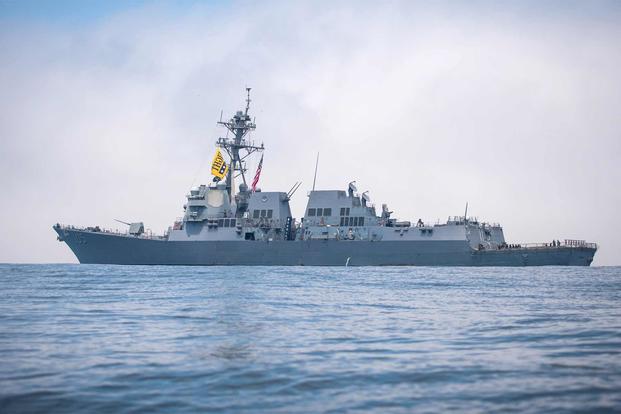The newest weapon in the Navy's arsenal is a laser dazzler that can stymie enemy drones threatening surface ships. And now it's installed aboard an active destroyer.
The system was installed aboard the Arleigh Burke-class destroyer Dewey in November, but not announced until this week, officials with Naval Sea Systems Command told Military.com.
Called Optical Dazzling Interdictor, Navy, or ODIN, the system is the technological successor of the Laser Weapons System, or LaWS, a 30-kilowatt laser installed on the amphibious transport dock Ponce in 2014. The ship conducted experiments in the Persian Gulf before the Ponce returned home for decommissioning in 2017; LaWS in its current form was never fielded.
The capabilities and specifications of ODIN have been closely guarded; a NAVSEA official declined to share additional information about how the system will be tested or what it can do.
Photos of the Dewey published on The Drive in November show a small turret mounted on the ship's deckhouse, in an area the publication notes is typically left open.
Officials have said plans call for two of the systems to be installed aboard destroyers in the near term.
"Going from an approved idea to installation in two and a half years, ODIN's install on Dewey will be the first operational employment of the stand-alone system that functions as a dazzler," officials said in a news release. "The system allows the Navy to rapidly deploy an important, new capability to the Navy's surface force in combating Unmanned Aircraft Systems (UAS) threats."
Hostile drones are a complex and growing threat to U.S. forces worldwide. In 2017, during a reporting trip to the carrier George H.W. Bush in the Persian Gulf, the ship's then-commanding officer, Capt. Will Pennington, noted that Iranian unmanned aerial vehicles were being used to gather information on Navy movements.
Dewey's upcoming experiments and operations with the laser will inform installation of ODIN aboard other ships and further development of Navy laser weapons, officials said.
Related: How to Defeat a Drone Attack: Raytheon Shows Off New Tech in Tabletop Exercise
The Department of the Navy's fiscal 2021 budget request included $68.2 million for the "Navy Laser Family of Systems," including the development of an "advanced prototype laser weapon system" at a strength of 60kW or higher for the purpose of helping surface ships counter enemy drones and defeat small boats.
The budget request also mentions another effort, an advanced 150kW high-energy laser demonstrator set to be installed on the amphibious transport dock Portland in fiscal 2021. That is likely the Solid-State Laser Technology Maturation, or SSL-TM, program in development by Northrop Grumman.
Another system set to be installed on a destroyer by 2021 is the High Energy Laser and Integrated Optical-dazzler and Surveillance, or HELIOS, a Lockheed Martin Corp.-developed prototype with a reported range of about five nautical miles. That system is set to have a 60kW laser, but could eventually increase to 150kW.
During a recent visit to the Dewey, then wrapping up its multi-month dry dock maintenance period in San Diego, Navy's head of research and development praised the work of the team that made the installation of the first shipboard laser a reality.
"This is a great example of our organic talent at the warfare centers all working together with ship's company to deliver a system which will provide game-changing capability," James Geurts, assistant secretary of the Navy for research, development and acquisition, said in a statement. "Bravo Zulu to the entire ODIN team on being mission-focused and delivering lethal capability to the warfighter."
-- Hope Hodge Seck can be reached at hope.seck@military.com. Follow her on Twitter at @HopeSeck.
Read more: Security Forces Leaders Fired for Fostering Toxic Work Environment












